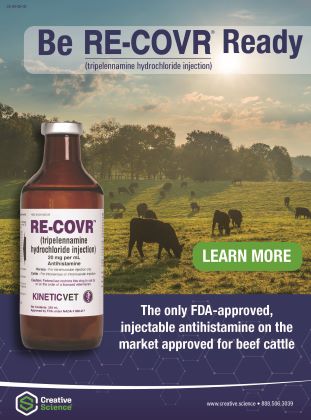Cattle Producers Should Be Alert over HPAI, Not Alarmed
Cattle Producers Should Be Alert over HPAI, Not Alarmed
Amid disease outbreaks, producers should examine their current biosecurity plans
Article and photo courtesy of Iowa State University
July 12, 2024 AMES, Iowa – Announcements of Highly Pathogenic Avian Influenza should not cause alarm among cattlemen, although this should alert producers to examine their current biosecurity plan, according to a beef specialist with Iowa State University Extension and Outreach.
Denise Schwab said the announcements are reminders of how any disease can spread to cattle.
“Basic biosecurity practices are essential daily steps for the prevention of all diseases, and cattlemen should always be alert to the potential of disease spread,” she said. “Diseases can be spread by aerosol, direct animal-to-animal contact, oral (through feed or water), reproduction, vector-born (biting or sucking insects), or by vehicles and fomites (shoes, clothes, contaminated feed, needles). Everything we do to prevent this spread reduces the risk of diseases.”
Direct animal-to-animal contact is the most significant risk for disease spread. Here are some management practices to minimize this risk:
- Isolate any incoming animals such as new bulls, purchased replacement heifers, purchased feeder calves, or animals returning home from exhibitions for 30 days.
- Maintain good perimeter fences to prevent neighboring bulls from breeding your cows and keep them in their pasture.
- Prevent nose-to-nose contact between your cow herd and newly purchased cattle.
- Minimize contact with wildlife when possible, and especially control rodents.
- Obtain the health history of purchased cattle.
- Limit who can access pens, feed storage, mixing areas, feed bunks and treatment areas.
- Clean and disinfect all equipment before using it around healthy cattle.
- Keep a record of all visitors to the operation.
Humans also are disease vectors, Schwab said.
“We control many management practices that can reduce disease spread,” she said. “Our shoes/boots and clothing can move bacteria and viruses, so having separate shoes/boots for the farm, changing after attending public livestock events such as fairs, auctions and field days before doing your chores, and preventing access to livestock areas by outside vehicles can help mitigate risk.”
It’s impossible to prevent all disease spread risks, but producers can minimize the impact by having and using sound management practices within their control. See information on biosecurity practices in the BQA Field Guide or work with your local veterinarian to identify disease risks in your area and mitigation practices to use.
Contact Schwab for more information at dschwab@iastate.edu or call 319-721-9624.




